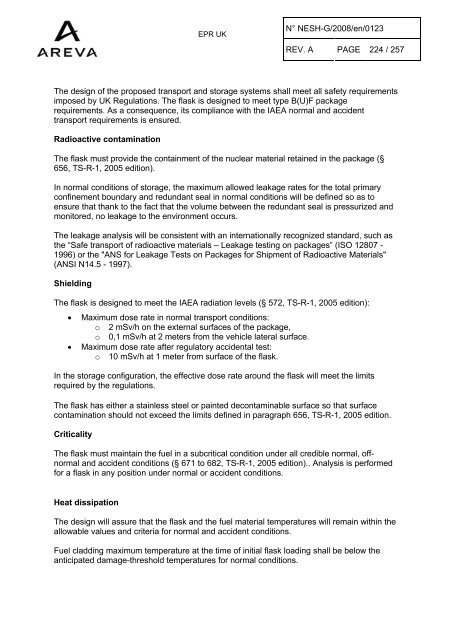Solid Radioactive Waste Strategy Report.pdf - UK EPR
Solid Radioactive Waste Strategy Report.pdf - UK EPR
Solid Radioactive Waste Strategy Report.pdf - UK EPR
You also want an ePaper? Increase the reach of your titles
YUMPU automatically turns print PDFs into web optimized ePapers that Google loves.
<strong>EPR</strong> <strong>UK</strong><br />
N° NESH-G/2008/en/0123<br />
REV. A PAGE 224 / 257<br />
The design of the proposed transport and storage systems shall meet all safety requirements<br />
imposed by <strong>UK</strong> Regulations. The flask is designed to meet type B(U)F package<br />
requirements. As a consequence, its compliance with the IAEA normal and accident<br />
transport requirements is ensured.<br />
<strong>Radioactive</strong> contamination<br />
The flask must provide the containment of the nuclear material retained in the package (§<br />
656, TS-R-1, 2005 edition).<br />
In normal conditions of storage, the maximum allowed leakage rates for the total primary<br />
confinement boundary and redundant seal in normal conditions will be defined so as to<br />
ensure that thank to the fact that the volume between the redundant seal is pressurized and<br />
monitored, no leakage to the environment occurs.<br />
The leakage analysis will be consistent with an internationally recognized standard, such as<br />
the “Safe transport of radioactive materials – Leakage testing on packages” (ISO 12807 -<br />
1996) or the "ANS for Leakage Tests on Packages for Shipment of <strong>Radioactive</strong> Materials"<br />
(ANSI N14.5 - 1997).<br />
Shielding<br />
The flask is designed to meet the IAEA radiation levels (§ 572, TS-R-1, 2005 edition):<br />
· Maximum dose rate in normal transport conditions:<br />
o 2 mSv/h on the external surfaces of the package,<br />
o 0,1 mSv/h at 2 meters from the vehicle lateral surface.<br />
· Maximum dose rate after regulatory accidental test:<br />
o 10 mSv/h at 1 meter from surface of the flask.<br />
In the storage configuration, the effective dose rate around the flask will meet the limits<br />
required by the regulations.<br />
The flask has either a stainless steel or painted decontaminable surface so that surface<br />
contamination should not exceed the limits defined in paragraph 656, TS-R-1, 2005 edition.<br />
Criticality<br />
The flask must maintain the fuel in a subcritical condition under all credible normal, offnormal<br />
and accident conditions (§ 671 to 682, TS-R-1, 2005 edition).. Analysis is performed<br />
for a flask in any position under normal or accident conditions.<br />
Heat dissipation<br />
The design will assure that the flask and the fuel material temperatures will remain within the<br />
allowable values and criteria for normal and accident conditions.<br />
Fuel cladding maximum temperature at the time of initial flask loading shall be below the<br />
anticipated damage-threshold temperatures for normal conditions.

















